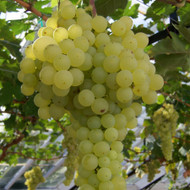In this second part of our guide to growing grape vines in the UK, we explore further how to grow them successfully, whether indoors or out. Think of grapevines and you’ll probably imagine long lines of tightly pruned vines, planted on the chalky slopes of southern France, baking under the Mediterranean sun. Sometimes it can be hard to envisage a successful crop in your own colder, wetter British garden. Growing in a greenhouse or poly tunnel is one option, but this may not be possible for many. However by picking a suitable variety you can get an excellent crop in most areas of the U.K., no matter whether you grow it outside or under cover. We’ll have a look at the pros and cons of each way of growing grapes, as well as growing vines in pots, and then look at some of the very best varieties you should consider.
Outdoors. Growing a vine outdoors is a very realistic proposition in almost all of the U.K. (if you pick the right variety!). They do need a position in full sun, but will tolerate just about all soils, except for very wet sites. They will enjoy the extra shelter of being grown against a wall or fence, but will still do well clothing a pergola or obelisk. They can be pruned to fit almost any space - or left to ramble freely over a shed or garage. The foliage makes an excellent back drop for summer flowers, and comes into its own in autumn when the leaves turn vibrant shades of red and orange. Ensuring adequate water is much less onerous than if growing undercover, and they suffer from few diseases. The most troublesome pests for outdoor vines are birds and wasps - it is well worth covering bunches with paper bags or stockings as the fruit start to ripen.
Indoors. Growing a vine inside a greenhouse or poly tunnel has definite advantages. The protection extends the growing season by several weeks, so helps fruit ripen properly. The extra warmth widens the choice of varieties- if you want to grow a seedless grape in most parts of the U.K., you’ll have to grow it undercover. Seedless varieties really need more early season heat than most gardens can guarantee. You’ll also be rewarded with the sweetest possible fruit by growing in a greenhouse. As an added bonus The luxuriant foliage can also be used to shade other plants from scorching in the middle of summer.
Growing vines inside is not without its drawbacks, however. Powdery mildew is probably the biggest problem, attacking foliage and stunting growth, and if left unchecked can ruin the crop. It’s aggravated by drought and stagnant air, so water copiously during warm spells, and keep greenhouse vents and doors open as much as possible. Regular pruning helps improve air flow, and monthly sprays of a foliage seaweed spray are also beneficial.
Pots. In many ways, pot culture can be a way to get the best of both worlds. Growing in large pots will reduce vigour, and mean you have less summer pruning to carry out. You can also move pots under cover if cold spring nights are forecast, but move outside in the summer to improve air circulation and greatly reduce the risk of mildew. Use the biggest pot you can (or you can reasonably move around), and fill with John Innes No 3 compost - it has the most nutrients in it, which the vine will enjoy. As with growing anything in a container, regular watering and feeding are the keys to success. The support you train the vine up can be as simple or complex as you like - trellis, stakes and wires or just a single sturdy bamboo cane will do the trick.
In the first few years, the aim is to create a permanent framework of branches, whether that is several to cover a wall, or just one main stem if growing up a cane in a pot. As these rods develop, they will start to produce side shoots, which is where fruit will develop in subsequent years. Side shoots should be prune back to two buds, and this should be done in the coldest days in winter. (The cold will stop the vines from bleeding from the pruning cuts).
As the weather warms up, growth will start from these short side spurs. Normally they produce three or for leaves and then a truss of flowers. Pollination is not normally an issue, but if it doubt give the branch a shake to help the pollen fly. Once the grapes have set, you then need to let a couple of leaves develop, before pruning the tip off the side branch. This stops the vine putting wasted energy into new growth and instead concentrate on the fruit. You will need to do this every few weeks over the summer, as the plant will continue to try and grow. It’s a little time consuming, but must be done regularly to get the best sized fruit which will ripen before the weather turns in autumn.
You will need to thin the fruit. Once fruitlets have set you should remove entire bunches to space out the fruit - one bunch every 60cm is plenty. Don’t be tempted to leave too many - vines are renowned for being over productive, and the resulting crop will stress the plant and cause issues with pest and disease. As summer progresses, you can also thin the fruit within individual bunches. This allows the remaining fruit to get to a good size and reduces the chances of mildew. You can remove as many as half of the pea-sized fruit. Try not to touch the fruit as you do this, as they are very easily bruised. A lazy way of getting almost the same result is just to pick a few fruit as they ripen, rather than cutting the entire bunch.
Summer feeding is essential. A couple of doses of blood fish and bone is enough, but if growing in pots, you can also give them any leftover tomato feed.
Best Outdoor Varieties.
Boskoop Glory. Bred in the 1950’s in the Netherlands, this is possibly the best choice for growing outside in colder parts of the U.K. Disease resistant and cold hardy, you’ll get reliable crops of dark purple fruit which are very sweet when fully ripe. Stunning autumn foliage colours.
Phoenix. A German hybrid bred in 1964. Excellent dessert quality white grapes with a hint of muscat flavour. Great disease resistance.
Regent. Another more recent German variety, which is extremely reliable in the UK climate. Excellent quality dark red fruit.
Best Indoor Varieties.
Chasselas Rose. An excellent choice for a cold greenhouse, producing long bunches of deep pink grapes. Can be used to make superb wine, but is also an excellent table grape.
Muscat of Alexandria. One of the oldest varieties in existence, thought to have originated in N Africa. Needs the warmth of a greenhouse to well in the U.K. but you’ll be rewarded with perfect large golden yellow fruit with a taste like pure nectar.
Schiava Grossa (also known as Black Hamburg). Large black grapes, super sweet, this is by far the most commonly offered variety and for good reason. Excellent quality fruit, but watch out for mildew.

